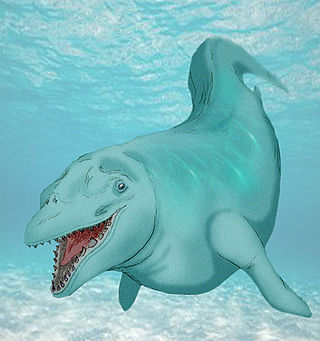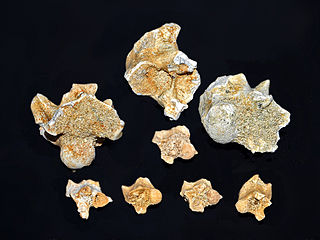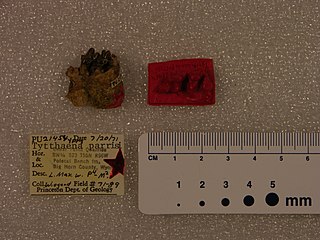
The Eocene is a geological epoch that lasted from about 56 to 33.9 million years ago (Ma). It is the second epoch of the Paleogene Period in the modern Cenozoic Era. The name Eocene comes from the Ancient Greek Ἠώς and καινός and refers to the "dawn" of modern ('new') fauna that appeared during the epoch.

The Fur Formation is a marine geological formation of Ypresian age which crops out in the Limfjord region of northern Denmark from Silstrup via Mors and Fur to Ertebølle, and can be seen in many cliffs and quarries in the area. The Diatomite Cliffs is on the Danish list of tentative candidates for World Heritage and may become a World Heritage site. Fossils found in the Fur Formation are primarily housed at the Fossil and Mo-clay Museum on Mors Island, the Fur Museum on Fur Island, and the Natural History Museum of Denmark in Copenhagen.

Kentisuchus is an extinct genus of gavialoid crocodylian, traditionally regarded as a member of the subfamily Tomistominae. Fossils have been found from England and France that date back to the early Eocene. The genus has also been recorded from Ukraine, but it unclear whether specimens from Ukraine are referable to Kentisuchus.
Conorbis is an extinct genus of sea snails, marine gastropod mollusks in the family Conorbidae.
Paleontology or palaeontology is the study of prehistoric life forms on Earth through the examination of plant and animal fossils. This includes the study of body fossils, tracks (ichnites), burrows, cast-off parts, fossilised feces (coprolites), palynomorphs and chemical residues. Because humans have encountered fossils for millennia, paleontology has a long history both before and after becoming formalized as a science. This article records significant discoveries and events related to paleontology that occurred or were published in the year 2011.

Trionyx is a genus of softshell turtles belonging to the family Trionychidae. In the past many species in the family were classified in this genus, but today T. triunguis, the African or Nile softshell turtle, is the only extant softshell still classified as Trionyx. The other species still assigned to this genus are only known from fossils. T. triunguis is a relatively large, aquatic piscivore.

Seminobatrachus is an extinct genus of neotenic salamander from late Paleocene to early Eocene deposits of Cherkassy Region, central Ukraine. It is known from 14 skeletons from a drill hole near Boltyshka village. It was first named by Pavel P. Skutschas and Yuri M. Gubin in 2011 and the type species is Seminobatrachus boltyschkensis.
Kaiika is an extinct genus of basal penguin from Early Eocene deposits of South Canterbury, New Zealand. It is known only from a single humerus. It was found in 1998 by Dr Phillip Maxwell, a paleontologist and stratigrapher, from the Kauru Formation of the Canterbury Basin, near the Waihao River. It was first named by Ewan Fordyce and Daniel Thomas in 2011 and the type species is Kaiika maxwelli. Kaiika is one of the oldest penguins known.
"Trionyx" ikoviensis is an extinct species of softshell turtles which existed in what is now Ukraine during the early Lutetian age of the Eocene epoch.
Indohyaenodon is an extinct genus of placental mammals from family Indohyaenodontidae within extinct order Hyaenodonta, that lived during the early Eocene in India.

Masracetus is an extinct genus of basilosaurid ancient whale known from the Late Eocene of Egypt.
Carolinacetus is an extinct protocetid early whale found in the Bartonian Tupelo Bay Formation in Berkeley County, South Carolina.
Eocetus is an extinct protocetid early whale known from the early-late Eocene Giushi Formation in Gebel Mokattam, outside Cairo, Egypt. Fossil remains have also been discovered in the Aridal Formation of the Sahara Desert in southwestern Morocco.

Palaeophiidae is an extinct family of marine snake within the infraorder Alethinophidia.
Suzanniwana is an extinct genus of iguanian lizards that lived in western North America during the earliest Eocene, approximately 56 million years ago. Two species are known from the Bighorn Basin of Wyoming: the type species S. patriciana named in 2009, and the species S. revenanta named in 2013. Suzanniwana lived during the Paleocene–Eocene Thermal Maximum, a brief period of global warming that resulted in warmer and drier conditions in the Bighorn Basin. It likely stemmed from a lineage that had migrated into the basin from regions farther to the south, following a latitudinal band of constant climatic conditions that moved northward as the planet warmed. Suzanniwana shares many skeletal features with modern casquehead lizards of the family Corytophanidae and may be a stem-corytophanid. It also closely resembles Geiseltaliellus, an iguanian from the middle Eocene Messel pit in Germany.
Anolbanolis is an extinct genus of iguanian lizards that lived in the Bighorn Basin of what is now Wyoming during the earliest Eocene. The type species A. banalis was named by paleontologist Krister Smith in 2009 from a collection of isolated skull fragments found in a layer of the Willwood Formation that dates to a brief period of global warming called the Paleocene-Eocene thermal maximum (PETM) about 56 million years ago. The genus name Anolbanolis means "poor anole" from the Greek anolbos and the name Anolis, in reference to the scrappy nature of known fossil material and its close resemblance to lizards in the genus Anolis. Smith suggested that Anolbanolis may be a close relative of Anolis or Polychrus, which are common today in Central and South America but not found as far north as Wyoming, fitting with the idea that the Bighorn Basin was warmer and wetter in the Eocene than it is currently. According to Smith, the species name banalis is a reference to it being a "banal" lizard in the Willwood, being "quite abundant in the type locality," and not unusual because "the discovery of Eocene boreal fossil members of living subtropical and tropical clades is becoming commonplace." In 2011 Smith named a second species of Anolbanolis, A. geminus, which lived in the Bighorn Basin shortly after the PETM and was about 50 percent larger than A. banalis. Smith concluded on the basis of features in A. geminus that Anolbanolis is more closely related to Anolis than it is to Polychrus.

Tytthaena is an extinct genus of placental mammals from extinct subfamily Tytthaeninae within extinct family Oxyaenidae, that lived in North America from the late Paleocene to early Eocene.

Rovno amber, occasionally called Ukrainian amber, is amber found in the Rivne Oblast and surrounding regions of Ukraine and Belarus. The amber is dated between Late Eocene and Early Oligocene, and suggested to be contemporaneous to Baltic amber. Major exploration and mining of the amber did not start until the 1990s.

Dipsocoridae are a family of heteropteran bugs known as jumping ground bugs. There are about 30 widely distributed species which are placed in three genera. Fossils from Eocene amber have also been placed in the family.









